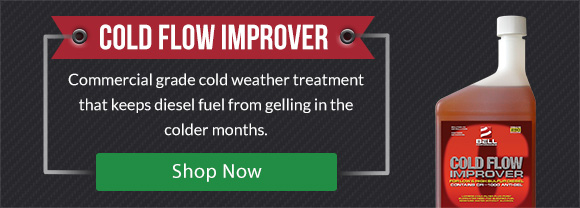With common rail diesel engines becoming the norm, engine manufacturers have been advising extra vigilance on diesel cold flow issues.
 Traditionally, diesel users in the winter have been advised to treat their fuel with cold flow improver before the fuel cools down to its cloud point – the temperature at which the wax crystals start becoming insoluble in the fuel and appearing in the fuel, giving it a cloudy appearance. Fuel gels as the temperature drops further and the wax crystals stick together and plug the fuel filter.
Traditionally, diesel users in the winter have been advised to treat their fuel with cold flow improver before the fuel cools down to its cloud point – the temperature at which the wax crystals start becoming insoluble in the fuel and appearing in the fuel, giving it a cloudy appearance. Fuel gels as the temperature drops further and the wax crystals stick together and plug the fuel filter.
While the cloud point temperature does vary from fuel batch to fuel batch (in other words, no two fuel s are exactly the same), most ultra-low sulfur diesel fuels have a cloud point in the 20s (deg F). That’s not a concern very often for users in the South, but up North, it very much is. Cold flow treatments are pretty effective at preventing diesel fuel gelling as the temperature drops below this, but only if they’re added to the fuel before the wax appears – when the fuel is warmer than the cloud point temperature.
The old way may not work anymore
Engine manufacturers are now telling us that this old protocol isn’t satisfactory anymore, because the fuel filters installed on common rail engines have tighter tolerances. They filter out small particles than ever before (to protect the valuable common rail system). This means that the fuel will effectively cause gelling problems at higher temperatures (sooner) than before. How much higher? Ballpark estimate is 10 degrees higher.
So if your diesel fuel has traditionally caused gelling issues at 20 degrees, you now need to plan for those issues at 30 degrees. If your local temperatures are already headed that way, now is the time to take action. Once the temperatures drop below those points, it will probably be too late.
You may be interested in the following posts:





 Traditionally, diesel users in the winter have been advised to treat their fuel with cold flow improver before the fuel cools down to its cloud point – the temperature at which the wax crystals start becoming insoluble in the fuel and appearing in the fuel, giving it a cloudy appearance. Fuel gels as the temperature drops further and the wax crystals stick together and plug the fuel filter.
Traditionally, diesel users in the winter have been advised to treat their fuel with cold flow improver before the fuel cools down to its cloud point – the temperature at which the wax crystals start becoming insoluble in the fuel and appearing in the fuel, giving it a cloudy appearance. Fuel gels as the temperature drops further and the wax crystals stick together and plug the fuel filter.